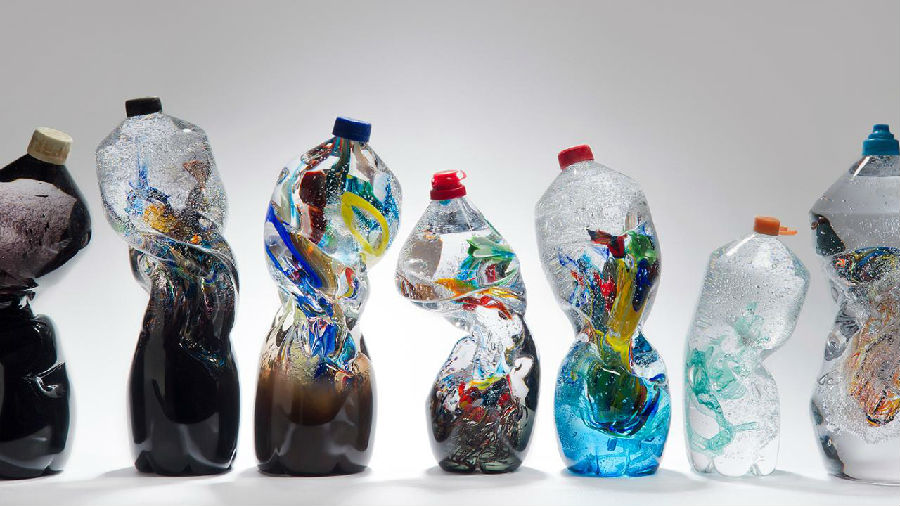And that’s been the major challenge for any kind of next-generation material to be able to compete with petroleum-based plastic products.
新一代材料,无论是什么材料,要想跟石油基塑料制品竞争,就要先过这一关。
“If you go to a dollar store, you see items which are about $1.
“如果你去一个一元商店,那你看到的商品价格就都在1美元上下。
So the product by itself has to be less than $1, along with the package.
所以,产品本身的价格,包括包装,必须控制在1美元以下。
So the package has to be relatively very, very cheap in order to succeed in the market.”
也就是说,要想不亏本,包装必须非常非常便宜。
To drive a competing material’s costs down that far,
要想将竞争材料的造价控制到塑料包装这么低,
it would have to be so easy to produce that it would be like pulling it out of thin air.
那这种材料必须极易生产,不费吹灰之力那种。
And according to Mango, that thin air is the delicious smell of methane,
而在芒果材料团队看来,这个灰就是从垃圾填埋场,
wafting from the landfills and wastewater treatment plants right in our backyard.
污水处理厂飘来的甲烷那芬芳的气味。
“We're able to pipe right off of the existing infrastructure that they have here.
“我们能直接接通他们现有的这些设施。
The tank that you see behind me here is called an "anaerobic digester".
我身后的那个大箱子叫“厌氧消化器”。
And that is where there's organisms called methanogens that live there and eat the waste, and actually produce methane, hence the name ‘methanogen’.
那就是一种名叫“甲烷菌”的生物生活,摄入废料,排出甲烷的地方,“甲烷菌”也是因此而得名的。
Behind me, we have the fermentor where the bacteria live, grow, and make the biopolymer.
我身后有一个发酵罐,细菌就在里面生存,繁殖,制造生物高聚物。
It actually happens in two stages.
这个过程其实分两个阶段。
So the first, we call reproduction, where we actually want the organisms to double,
第一阶段,我们称之为“繁殖”阶段,我们希望在这个阶段有机体的数量能够翻倍,
and then, we actually want all of those millions of organisms to transform,
接下来一个阶段,我们希望那成百上千万的细菌开始转化,
which means to take that carbon and build up the biopolymer, polyhydroxyalkanoate, inside of cell walls.
也即摄入碳,提升细胞壁内生物聚合物聚羟基脂肪酸酯的水平。
Once they are fat and happy, we basically have to pull the polymer out of their cell walls through the harvesting step.
等它们吃得肥肥胖胖,心满意足以后,我们只需通过采集手段把它们细胞壁内的聚合物提取出来就可以了。
We'll remove the cell mass, as we don't need that part -
首先要移除细胞团,因为这部分我们不需要——
We really want the powder, which is actually in step six where we've removed the water, and you're left with the powder.
我们真正需要的是聚羟基脂肪酸酯粉末,这就是我们的第六步,也即移除多余的水分,留下聚羟基脂肪酸酯粉末。
But in order for it to be turned into various products,
但要将这种粉末制成各种各样的产品,
it generally needs to be in pellet form, which is step seven.”
我们通常还需要将它们制成颗粒,也就是我们的第七步。
“If we want to look at what the utopian future could be,
“如果我们想知道理想的未来是什么样,
in my book, it would be anaerobic digestion to materials, to fuels, to energy.
在我看来,应该是厌氧菌充当各种材料,燃料以及能量来源的一个世界。
So, we could take these local, decentralized, already-existing facilities - they're already collecting some form of waste.
所以,我们可以把这些地方的,分散的,或是已经存在的设施利用起来,它们已经在收集某些废料了。
They can anaerobically digest it to methane.
它们能够对那些废料进行厌氧消化,将其转化成甲烷。

Then we are dealing with our waste onsite.
这样一来,我们就能对废料加以当场利用了。
And not only that, we are creating a more resilient economy,
不仅如此,这么做我们也是在打造一种更具弹性的经济模式,
because we can actually use this material, that's seen as a waste,
因为我们真的能够将这种材料,这种被视为废弃物的材料利用起来,
as a feedstock to the everyday materials and products we need."
将其用为我们日常所需的材料或产品的原料。”
For Molly and her team today, those products are fibers for textiles, small packaging items, and even 3d-printed tools for use in space.
而在莫莉和她的团队看来,这类产品包括纺织用的纤维,小型包材,甚至是用于太空的3D打印工具。
But by slowly building demand and improving their production process,
不过,通过缓步扩大需求,改进生产工艺,
they believe that soon they’ll be able to work with something like plastic bags.
他们相信,不久之后,他们就能生产塑料袋之类的东西了。
"One of the amazing things about PHAs is they can be tailored for lots of different applications.
“PHA这种材料的一大优点便是它可以很好地胜任各种各样的用途。
So you can get different properties, whether it's mechanical properties, processing, or even end-of-life biodegradability properties.
也就是说我们可以从它身上获取各种各样的性能,无论是机械性能,工艺性能,还是生命周期结束后的生物降解性能,它都具备。
PHAs can also biodegrade in your backyard compost, so home compost, or even environments where no oxygen is present.
这种材料在你后院的堆肥箱,也就是那种家用堆肥箱,甚至是没有氧气的自然环境里就能自行生物降解。
It could give producers and other people in the value and supply chain reassurance
因此它堪称是生产方以及价值与供应链中的其他方的一剂定心丸,
that it won't be polluting indefinitely for hundreds or thousands of years."
因为它不会源源不断地给环境造成成千上万年的污染。
So if all we need to do is mentor some methane-munching microbes to produce PHA at scale using waste facilities all over the world,
那么问题来了,如果我们只需将世界各地的废物处理设施利用起来,然后指导那些以甲烷为食的细菌大规模产出PHA,
gradually build the capacity we need to compete with petrochemical plastics,
就能逐步搭建起与石化塑料抗衡的产能,
and sit back and watch as our landfills become gold mines,
坐看我们的垃圾堆变成一个个的金矿的话,
How close are we to re-inventing plastic?
那我们距离实现对塑料的彻底改造究竟还有多久呢?
"We are having a technological leap forward.
“技术性的飞跃已经开始了。
So the technology of the next generation of plastics is already here;
也就是说,研制新一代塑料的技术已经有了;
and it's the infrastructure that we have to develop around it.
现在的瓶颈在于服务这一技术的基础设施还没跟上。
Whether it's bioplastics, compostable plastics, or whether it is processing once the infrastructure is in place,
无论最终研制出来的是生物塑料,可堆肥塑料,也无论基础设施一到位它是否就能投产,
we'll have the next generation of plastics taking over."
我们都会让新一代的塑料‘继承大统’。”
"So, we're very close to replacing petroleum and polluting plastics.
“总而言之,我们距离淘汰污染严重的石油基塑料的日子已经很近了。
These materials are already here.
我们手上已经有新材料了。
If everything just fell into place, we'd be looking at single digit years to get there."
如果各方面的工作都能到位的话,不用10年,我们就能完成这项工作。”
"There's a sweet spot between technology and economics.
“科技和经济之间存在一个最佳契合点。
Packaging and plastics play a very important role in the success of the supply chain.
包装和塑料对供应链的成功发挥着非常重要的作用。
Sustainable plastics, they are going to grow from here on - there's no doubt about that.
此时此刻,将会成为可持续塑料时代的起点,这一点是毫无疑问的。
So once the cost of the production, the infrastructure lines up, I see a very bright future for the bioplastics out there."
所以,只要生产投入、基础设施都能到位,在我看来,生物塑料的前景是非常光明的。”
Methane might stink, but our youtube channel sure doesn't.
甲烷的味道可能会让你觉得辣眼睛,我们的YouTube频道肯定不会。
Make sure to subscribe for all your science news
记得订阅我们的频道,将所有科学新闻一网打尽,
Check out our website at seeker.com, our instagram, @seeker, our facebook, /seekermedia,
你还可以浏览我们的网站seeker.com,或关注我们的IG账号 @seeker,以及我们的Facebook账号/seekermedia,
and, for more about plastic, check out this episode of elements where we cover a team trying to pull it all out of the pacific ocean.
想了解更多关于塑料的知识,请看《元素》系列视频的这一期内容,在这期视频中,我们报道了一个团队试图清理太平洋所有塑料垃圾的故事。
It's a lot of work.
他们的工作量真的超大。
Anyway, thanks for watching!
无论如何,感谢大家的收看!
See ya next time!
下次节目再见啦!












